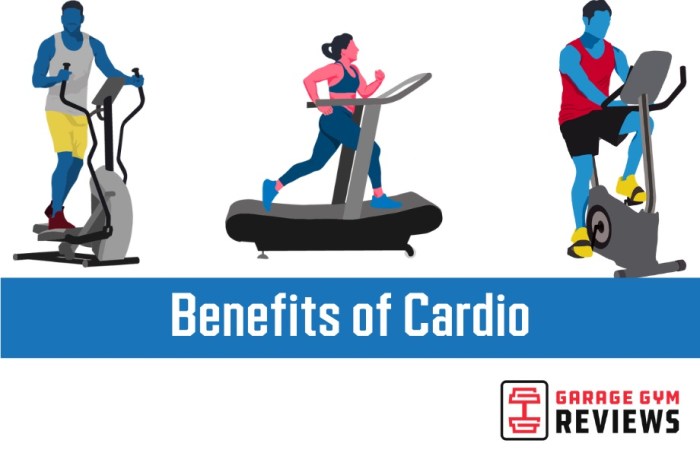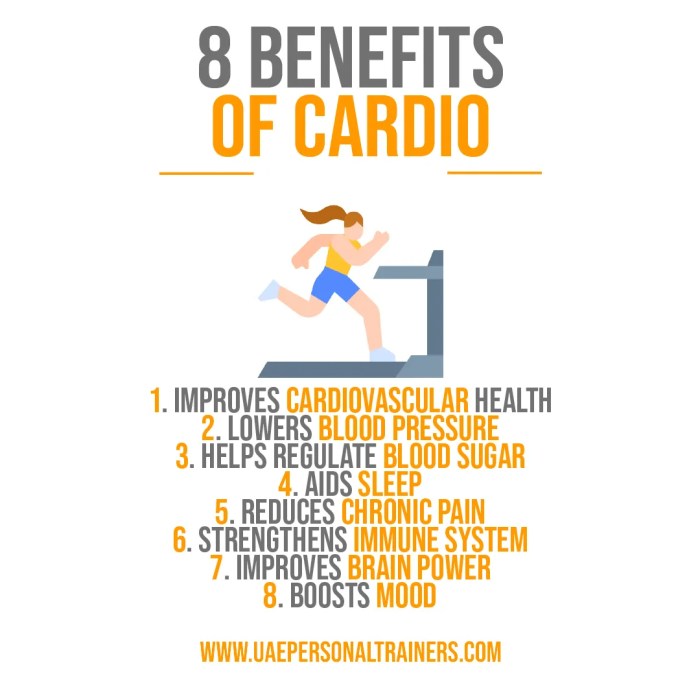
Ready to ditch the couch and unleash your inner Olympian (or at least your inner slightly-less-winded self)? Cardio workouts aren’t just about burning calories; they’re a passport to a healthier, happier, and frankly, more awesome you. Think of it as a high-intensity hug for your heart, a metabolic makeover, and a mood booster all rolled into one sweaty, satisfying session.
Prepare for a journey into the exhilarating world of cardio, where your body becomes a finely-tuned machine, and your mind finds its zen.
We’ll explore the incredible benefits of cardio, from strengthening your heart and boosting your mood to improving lung function and even indirectly contributing to muscle strength. Get ready to discover why lacing up those trainers is the best decision you’ll make all day (besides maybe choosing that extra slice of pizza… just kidding… mostly).
Cardiovascular Health Improvements

Let’s get one thing straight: cardio isn’t just about shedding those extra pounds (though that’s a nice bonus!). It’s about giving your heart a serious upgrade, turning it from a slightly rusty old engine into a finely tuned, high-performance machine. Think of it as a total heart makeover, but without the awkward photos.Cardio workouts significantly impact your cardiovascular system, boosting its efficiency and resilience.
This isn’t some magical fairy dust; it’s the result of consistent exercise improving your heart’s function and your body’s ability to deliver oxygen and nutrients. Prepare to be amazed (and maybe a little breathless) as we delve into the details.
Impact of Cardio on Heart Rate, Blood Pressure, and Cholesterol
Regular cardio training leads to a lower resting heart rate. This is because your heart becomes stronger and more efficient, requiring fewer beats to pump the same amount of blood. Think of it as your heart getting a promotion – less work, same results! Similarly, sustained cardio exercise helps lower blood pressure by improving the elasticity of your blood vessels and reducing vascular resistance.
Imagine your blood vessels as flexible pipes – the more flexible they are, the easier it is for blood to flow smoothly. Finally, cardio can improve your cholesterol profile, increasing levels of “good” HDL cholesterol and lowering “bad” LDL cholesterol. This reduces your risk of heart disease and clogged arteries, keeping those vital pipelines clear and flowing.
Strengthening the Heart Muscle Through Cardio
Cardio exercise strengthens the heart muscle (myocardium) through a process called cardiac hypertrophy. This isn’t the kind of hypertrophy that bodybuilders strive for; it’s a healthy increase in the size and strength of the heart muscle cells. With each workout, your heart works harder, adapting and growing stronger to meet the increased demands. This results in a more powerful pump, improving your heart’s ability to deliver oxygen-rich blood throughout your body.
It’s like giving your heart muscle a serious workout at the gym – except the gym is your living room, and the weights are your own body weight and determination.
Examples of Cardio Exercises and Their Cardiovascular Benefits
Choosing the right cardio exercise is crucial. Here’s a table showcasing a few popular options and their respective effects:
| Exercise | Intensity | Duration (per session) | Benefits | Equipment Needed |
|---|---|---|---|---|
| Running | Moderate to High | 30-60 minutes | Improved cardiovascular fitness, weight loss, increased endurance | Running shoes |
| Swimming | Moderate to High | 30-60 minutes | Full-body workout, low-impact, improved cardiovascular fitness | Swimming pool, swimsuit |
| Cycling | Low to High | 30-60 minutes | Improved cardiovascular fitness, leg strength, weight loss (depending on intensity) | Bicycle |
| Dancing | Low to Moderate | 45-90 minutes | Improved cardiovascular fitness, coordination, mood boost | Music, comfortable shoes (optional) |
Weight Management and Metabolism
Cardiovascular exercise isn’t just about a healthy heart; it’s a powerful tool in the fight against unwanted pounds and a sluggish metabolism. Think of it as a double-whammy against those pesky extra kilos – it burns calories during the workout and boosts your body’s calorie-burning capacity even when you’re resting on the couch, watching cat videos (guilty!).Cardio’s magic lies in its ability to elevate your heart rate, forcing your body to tap into its energy stores (aka fat) for fuel.
The more intense and longer the cardio session, the more calories you torch. This calorie deficit is crucial for weight loss, as it forces your body to use stored fat for energy, leading to a reduction in overall body weight. But the benefits extend far beyond just the workout itself; it also significantly impacts your resting metabolic rate (RMR).
Resting Metabolic Rate Enhancement
Your resting metabolic rate (RMR) is the number of calories your body burns at rest to maintain basic bodily functions. Think breathing, heartbeat, and keeping your organs humming along. Regular cardio training doesn’t just burn calories during exercise; it actually increases your RMR. This means you’ll burn more calories even when you’re not actively working out – it’s like having a tiny, tireless calorie-burning furnace working 24/7.
Studies have shown that consistent cardio can lead to a noticeable increase in RMR, making weight management easier in the long run. This effect is partly due to increased muscle mass (even from activities that don’t seem overtly muscle-building) and improved metabolic efficiency. Imagine your body becoming a more efficient calorie-burning machine, effortlessly shedding those extra pounds.
Calorie Expenditure Comparison Across Cardio Activities
The number of calories you burn during cardio depends on several factors, including the intensity and duration of the workout, your weight, and the type of activity. Understanding this variation allows you to tailor your workouts to your goals and preferences.Let’s compare the approximate calorie expenditure per hour for a 150-pound person engaging in various cardio activities at a moderate intensity:
- Brisk Walking: Around 250-300 calories. Think a good, energetic stroll, not a leisurely amble.
- Cycling (moderate pace): Approximately 300-400 calories. Think a comfortable pace where you can hold a conversation, not sprinting uphill.
- Swimming (moderate pace): Roughly 400-500 calories. The water resistance adds an extra challenge, making it a highly effective calorie burner.
- Running (moderate pace): Around 400-600 calories or more. This highly depends on speed and terrain. A gentle jog will burn fewer calories than an interval run.
- High-Intensity Interval Training (HIIT): Can burn 500-800 calories or more in a shorter time frame. This involves short bursts of intense exercise followed by brief recovery periods. Think sprinting for 30 seconds, then walking for 60 seconds, repeated several times.
Remember, these are estimates. Using a fitness tracker or heart rate monitor can provide a more personalized measurement of your calorie expenditure. The key is to find a cardio activity you enjoy and can stick with consistently, ensuring you’re burning calories and boosting your metabolism in the process.
Mental Well-being and Stress Reduction
Cardio isn’t just about a fitter physique; it’s a powerful tool for sharpening your mind and calming your nerves. Think of it as a mental spa day, but instead of cucumber water, you get a satisfying sweat and a serious endorphin rush. Research consistently shows a strong link between regular cardiovascular exercise and improved mental health, helping to banish the blues and boost your overall well-being.Numerous studies have demonstrated the positive impact of cardio on stress reduction.
For example, a meta-analysis published in the British Journal of Sports Medicine revealed that aerobic exercise significantly reduced anxiety and depression symptoms in participants. This isn’t just about feeling better; it’s about measurable improvements in mental health indicators. The effect is comparable to, and in some cases surpasses, the benefits of certain types of therapy. This isn’t to say cardio replaces therapy, but it’s a powerful complementary tool for managing mental health challenges.
Cardio’s Mood-Boosting Mechanisms
Cardio workouts trigger the release of endorphins, those magical neurochemicals often dubbed “feel-good hormones.” Endorphins act as natural painkillers and mood elevators, reducing feelings of stress and anxiety while simultaneously boosting feelings of happiness and well-being. Imagine your brain releasing tiny, happy soldiers to fight off the stress-inducing villains. This isn’t just a metaphorical description; it’s a biological reality that has been extensively documented.
The intensity and duration of your workout influence the endorphin release, meaning a longer, more challenging session can yield a more pronounced mood boost. This isn’t about pushing yourself to the point of exhaustion, but finding a sustainable level of intensity that works for you.
The Impact on Anxiety and Depression
Regular cardio exercise has been shown to be highly effective in mitigating symptoms of anxiety and depression. By reducing stress hormones like cortisol and increasing endorphins, cardio helps to regulate the neurochemical imbalances often associated with these conditions. It provides a natural way to manage symptoms, promoting a sense of calm and control. This is particularly relevant given the growing prevalence of anxiety and depression in modern society, highlighting the crucial role that exercise can play in overall mental health.
The improvement isn’t always immediate; consistency is key. Think of it like building a muscle – the more you train, the stronger and more resilient your mental well-being becomes.
Improved Lung Function and Respiratory Health
Let’s face it, breathing is kind of important. We do it all the time, mostly without thinking about it, like a well-oiled (and hopefully not rusty) machine. Cardiovascular exercise, however, can help tune up that breathing machine, making it more efficient and powerful. Think of it as a lung-powered upgrade for your body.Regular cardio workouts significantly improve lung capacity and overall respiratory health.
This isn’t just about puffing out your chest (though that might be a nice side effect); it’s about increasing your body’s ability to take in oxygen and expel carbon dioxide. This improved efficiency translates to increased stamina, less breathlessness during physical activity, and a generally more comfortable breathing experience. The impact is particularly noticeable during exertion, but the benefits extend to everyday life, leading to improved quality of life.
Increased Oxygen Uptake and Breathing Efficiency
Cardiovascular exercise strengthens the respiratory muscles, including the diaphragm and intercostal muscles, which are responsible for the mechanics of breathing. This strengthening leads to a more efficient breathing pattern, meaning you can take in more oxygen with each breath and expel carbon dioxide more effectively. The increased oxygen uptake fuels your muscles and organs, improving performance and endurance.
Think of it like upgrading your car’s engine – more oxygen equals more power. This improved efficiency also reduces the work your respiratory system needs to do, leading to less breathlessness and improved overall respiratory function.
Cardio Exercises for Individuals with Respiratory Conditions
Choosing the right type of cardio is crucial, especially for those with respiratory conditions. The key is to start slowly and gradually increase intensity and duration. Always consult with your doctor or a respiratory therapist before starting any new exercise program.
Low-impact activities like walking, swimming, and cycling are excellent choices. These exercises minimize stress on the joints and respiratory system, allowing for gradual improvement without causing excessive strain. Walking, in particular, is easily adaptable to different fitness levels and can be performed almost anywhere.
Water-based exercises, such as swimming or water aerobics, offer added benefits due to the buoyancy of water, which reduces the workload on the lungs and joints. The resistance of water also provides a good workout without excessive strain.
Cycling is another low-impact option that allows for adjustable intensity. It’s a great way to build endurance and improve cardiovascular fitness while minimizing respiratory stress. Stationary bikes offer even more control and convenience.
Muscle Strength and Endurance (Indirect Benefits)
While cardio might not be the first thing that springs to mind when you think of building bulging biceps, it plays a surprisingly significant role in boosting your overall muscle strength and endurance. Think of it as the unsung hero of the fitness world, quietly supporting your gains from other workouts. It’s not about replacing weight training, but rather enhancing its effectiveness and contributing to a more well-rounded physique.Cardiovascular fitness and muscular performance are intimately linked.
A stronger heart and more efficient lungs deliver oxygen and nutrients to your muscles more effectively. This improved delivery system means your muscles can work harder for longer before fatiguing. Imagine your muscles as a high-performance engine; cardio is the upgrade to its fuel injection system, allowing it to operate at peak efficiency.
Cardiovascular Fitness and Muscle Performance
Improved cardiovascular fitness directly impacts muscle performance in several ways. Firstly, increased blood flow delivers more oxygen to working muscles, delaying the onset of muscle fatigue. Secondly, enhanced capillary density (the network of tiny blood vessels in muscles) improves nutrient delivery and waste removal, further enhancing muscle function. Finally, a stronger heart pumps blood more efficiently, reducing recovery time between sets or workouts.
This translates to increased stamina and the ability to perform more reps or maintain higher intensity for longer periods.
Comparison of Muscle Building Potential
Let’s face it: if you’re aiming for massive muscle growth, resistance training is king. However, cardio plays a vital supporting role. The following table highlights the key differences in how each approach contributes to muscle strength and endurance.
| Cardio | Resistance Training |
|---|---|
| Increases endurance and stamina, allowing for longer workouts and more reps over time. Improves cardiovascular health, supporting efficient nutrient delivery to muscles. Indirectly strengthens muscles by improving overall body function and reducing recovery time. | Directly builds muscle mass and strength through progressive overload. Leads to significant increases in muscle size and power. Develops specific muscle groups. |
HEALTH FITNESS
Pumping iron is great, but let’s be honest, cardio is the real unsung hero of a long and healthy life. It’s not just about burning calories; it’s about building a body that’s a finely-tuned machine, humming along for decades to come. Regular cardio exercise significantly impacts your lifespan and quality of life, boosting your overall health and well-being in ways you might not even realize.Cardio exercise profoundly affects your longevity and the quality of those years.
It’s not just about adding years to your life, but adding life to your years. By strengthening your cardiovascular system, you’re building a resilient foundation against the wear and tear of everyday life and the onslaught of age-related diseases. This translates to more energy, greater vitality, and the ability to enjoy life’s adventures for longer. Think of your heart as a car engine – regular maintenance (cardio!) keeps it running smoothly and prevents costly breakdowns (chronic diseases) down the line.
Cardio’s Impact on Chronic Disease Risk
Regular cardio significantly reduces the risk of developing numerous chronic diseases, including heart disease, stroke, type 2 diabetes, and certain types of cancer. These diseases are major contributors to mortality and morbidity worldwide, so strengthening your cardiovascular health through regular exercise is a powerful preventative measure. The benefits extend beyond simply avoiding illness; cardio helps manage existing conditions, improving symptoms and reducing the need for medication in some cases.
For instance, regular exercise can help manage blood sugar levels in individuals with diabetes, reducing the risk of complications. Similarly, it can lower blood pressure and cholesterol levels, decreasing the risk of heart attack and stroke.
Illustrative Examples of Cardio’s Impact
Let’s meet some real-life champions of cardio.First, consider Maria, a 60-year-old retired teacher who was diagnosed with pre-diabetes five years ago. Her doctor recommended lifestyle changes, including regular cardio exercise. Initially, Maria struggled, starting with short walks around the block, often feeling winded. But she persevered. Gradually, she increased the intensity and duration of her workouts, eventually taking up brisk walking and then jogging.
Today, Maria regularly runs 5k races, her pre-diabetes is under control, and her energy levels are through the roof. She’s a testament to the power of consistent effort and the transformative impact of cardio.Then there’s David, a 45-year-old office worker who always felt sluggish and lacked energy. He decided to start cycling to work, a 30-minute ride each way.
At first, it was challenging, but over time, he noticed a significant improvement in his stamina and mood. He lost weight, his blood pressure decreased, and his overall health improved drastically. His newfound energy allowed him to spend more quality time with his family and pursue hobbies he had previously neglected. His transformation is a shining example of how integrating cardio into a daily routine can revitalize both physical and mental health.
Closure

So there you have it – a compelling case for incorporating regular cardio into your life. From the rhythmic thump of your heart to the exhilarating rush of endorphins, the benefits extend far beyond just physical fitness. It’s an investment in your overall well-being, a celebration of your body’s incredible capabilities, and a ticket to a longer, healthier, and more vibrant life.
Now go forth and conquer that treadmill (or dance floor, or hiking trail – your choice!).
Quick FAQs
What’s the best type of cardio for beginners?
Start slow and steady! Walking, swimming, or cycling at a moderate pace are excellent choices. Listen to your body and gradually increase intensity and duration.
How often should I do cardio?
Aim for at least 150 minutes of moderate-intensity cardio or 75 minutes of vigorous-intensity cardio per week, spread throughout the week. Consult your doctor for personalized advice.
Can cardio help with sleep?
Absolutely! Regular cardio can improve sleep quality by regulating your circadian rhythm and reducing stress and anxiety. Just avoid intense workouts close to bedtime.
Is cardio good for people with joint problems?
Low-impact cardio options like swimming, cycling, or water aerobics are generally gentler on the joints. Always consult your doctor or physical therapist before starting any new workout routine.





